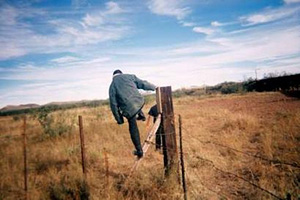 |
 |
 |
 News from Around the Americas | September 2006 News from Around the Americas | September 2006  
Border Fence Still Roils GOP in House, Senate
 Carolyn Lochhead - SF Chronicle Carolyn Lochhead - SF Chronicle


| | An unidentified illegal immigrant climbs a barb wire fence in this undated photo released to Reuters on September 21, 2006 that is part of the 'Border Film Project' on exhibit at the Scottsdale Museum of Contemporary Art. A group of artists gave more than 600 disposable cameras to would be immigrants in Mexico's northern Sonora State, and to Minutemen volunteers in Arizona, and asked them to take personal snapshots of life around the border. (Reuters/The Border Film Project) |
Senate and House Republicans seeking broad changes in immigration law conceded Tuesday that a 700-mile fence on the Mexican boarder will probably pass the Senate this week, but warned the fence will not stop illegal immigration and that lawmakers will continue after the November election to try to expand the ways to gain legal entry into the United States.

After weeks in which hard-line House Republicans have dominated the immigration debate, the ferocity of underlying GOP divisions on the issue broke into vivid public view on Capitol Hill.

Richard Land, president of the public policy arm of the Southern Baptist Convention, compared House Judiciary Committee Chairman James Sensenbrenner's approach to illegal immigration to the Fugitive Slave Act of 1850. Former House Republican leader Dick Armey recalled that President Ronald Reagan wanted to tear down walls, not build them.

"Political discourse many times is captured by - what should I say - the most primitive thought process," Armey said at a press conference. "This has been rallied up by a lot of people that are very visible and make a lot of noise, but have never been guilty of any deep thinking."

Armey added that he was "really surprised and disappointed in Jim Sensenbrenner."

Sensenbrenner, R-Wis., wrote the bill that passed the House in December to build the fence and make illegal presence in the country a felony, stirring the nation's first large street protests by Latinos.

The Senate, in a bipartisan coalition, answered with a much broader bill that would have provided a way for many of the estimated 12 million illegal immigrants to become U.S. citizens.

Facing an impasse over the two approaches, House Republican leaders repackaged the Sensenbrenner bill into several smaller components, including the fence, but dropped a few of the most controversial original items, such as criminalizing those who help illegal immigrants.

After being ridiculed for months, the border fence idea has gained support from members in both parties. House leaders are trying to incorporate the other measures into a spending bill.

Senate Republicans who supported tying tougher border measures with wider avenues to migrate legally - either through a temporary worker program or some form of legalization for the 12 million illegal immigrants now in the country - said they would press on either next year or in a lame-duck session after the midterm elections.

Sen. Arlen Specter, the Republican chairman of the Senate Judiciary Committee, said Tuesday he "would not rest" until a comprehensive approach is achieved, and he admonished House Republicans that Congress has two chambers, not just one.

Specter said he worried, however, that taking a "piecemeal approach" would undermine the political foundation for a broader bill, which has always been built on a trade-off between a border crackdown and legalization. The Senate bill contained a 370-mile border-fence plan.

Sen. John McCain, the Arizona Republican who sponsored the Senate bill with Sen. Edward Kennedy, D-Mass., said there was no argument about border security.

"We have no dispute that border security and national security are our top priority," McCain said, "but we also strongly assert that it has to be a comprehensive approach because you can't just leave 12 million people in this country with nothing being done about their status, nor can we ignore the needs of the labor market."

Sen. Lindsey Graham, R-S.C., another key Republican sponsor of the Senate bill, said a border crackdown alone will not work because a large proportion - one-third or more - of the illegal immigrants in the country arrived legally on tourist, student or other visas, and remained after the visas expired.

Kennedy said the administration already has authority to erect barriers on the border, and the Homeland Security Department last week announced a contract award to Boeing to begin construction of a "virtual fence" near Tucson, part of a much larger "Secure Border Initiative" that could cost $2 billion.

Rep. Mike Pence, R-Ind., and Sen. Kay Bailey Hutchison, R-Texas, continued to tout what they called a middle ground between the Senate and House. The plan would require all immigrants in the country illegally to leave and register at a privately run "Ellis Island Center" in Mexico or Central America, where they would be matched with a job in the United States, undergo a background check, and obtain a fraud-proof visa.

Conservative House Republicans have attacked that approach as amnesty, too, but Pence insisted that it is not because all illegal immigrants would have to leave the country to apply.

No fence without a guest worker program will work, said Armey, who backed the Pence-Hutchison approach. Armey pointed to the Bracero program for Mexican farm workers in the 1950s, when apprehensions of illegal immigrants plummeted from more than 1 million a year to less than 50,000, and then rose sharply again when the program ended in 1964.

"I don't care who you are, if you've got little ones, you're going to find a way to feed them," Armey said. "It just infuriates me, the kind of discussion here that doesn't recognize this."

Illegal immigrants, he said, are "doing the same thing you and I would do - the same thing that East Germans were doing when they tried to scramble over their wall."

Email Carolyn Lochhead at clochhead@sfchronicle.com. | 
 | |
 |



